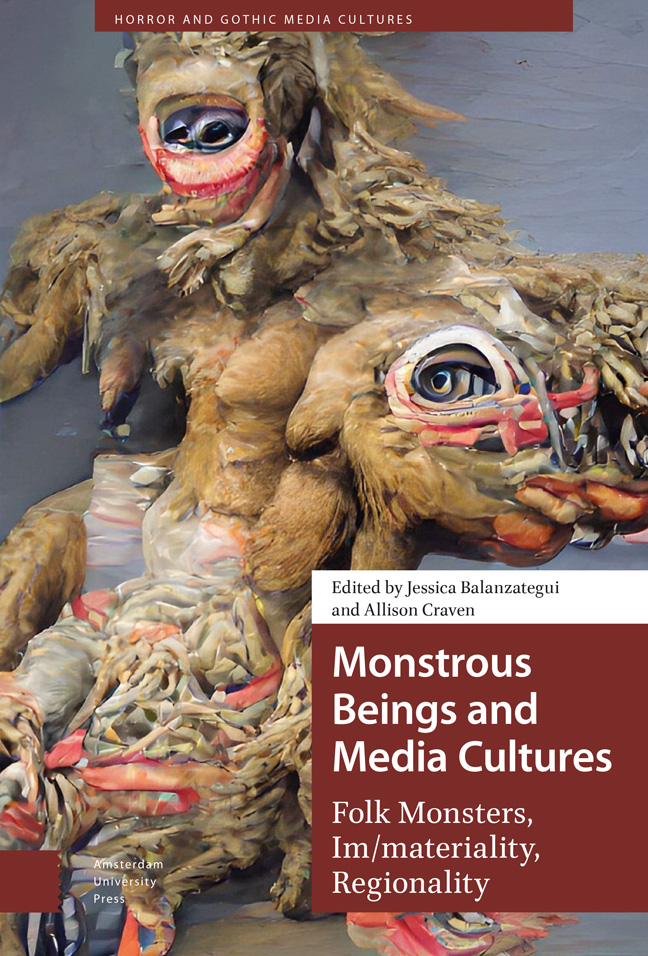Book contents
- Frontmatter
- Contents
- List of Figures
- Acknowledgements
- Introduction: Folk Monsters and Monstrous Media: The Im/materialties, Modalities, and Regionalities of Being(s) Monstrous
- 1 The Momo Challenge as Urban Legend: Child and Adult Digital Cultures and the Global Mediated Unconscious
- 2 “Every Imaginable Invention of the Devil”: Summoning the Monstrous in Eurocentric Conceptions of Voodoo
- 3 The Forest and the Trees: The “Woods” as Intersection between Documentary, Fairy Tale, and Internet Legend in Beware the Slenderman
- 4 Mark Duplass as Mumblegore Serial Killer: Fictional Vernacular Filmmaking in the Creep Series
- 5 Monsters in the Forest: “Little Red Riding Hood” Crimes and Ecologies of the Real and Fantastic
- 6 A Mother's Milk: Motherhood, Trauma, and Monstrous Children in Folk Horror
- 7 Documenting the Unheard: The Poetics of Listening and Empathy in The Family
- 8 Reimagining the Pontianak Myth in Malaysian Folk Horror: Flexible Tradition, Cinema, and Cultural Memory
- 9 An Uncommon Ancestor: Monstrous Emanations and Australian Tales of the Bunyip
- 10 The Folk Horror “Feeling”: Monstrous Modalities and the Critical Occult
- Works Cited
- Mediagraphy
- Index
10 - The Folk Horror “Feeling”: Monstrous Modalities and the Critical Occult
Published online by Cambridge University Press: 17 February 2024
- Frontmatter
- Contents
- List of Figures
- Acknowledgements
- Introduction: Folk Monsters and Monstrous Media: The Im/materialties, Modalities, and Regionalities of Being(s) Monstrous
- 1 The Momo Challenge as Urban Legend: Child and Adult Digital Cultures and the Global Mediated Unconscious
- 2 “Every Imaginable Invention of the Devil”: Summoning the Monstrous in Eurocentric Conceptions of Voodoo
- 3 The Forest and the Trees: The “Woods” as Intersection between Documentary, Fairy Tale, and Internet Legend in Beware the Slenderman
- 4 Mark Duplass as Mumblegore Serial Killer: Fictional Vernacular Filmmaking in the Creep Series
- 5 Monsters in the Forest: “Little Red Riding Hood” Crimes and Ecologies of the Real and Fantastic
- 6 A Mother's Milk: Motherhood, Trauma, and Monstrous Children in Folk Horror
- 7 Documenting the Unheard: The Poetics of Listening and Empathy in The Family
- 8 Reimagining the Pontianak Myth in Malaysian Folk Horror: Flexible Tradition, Cinema, and Cultural Memory
- 9 An Uncommon Ancestor: Monstrous Emanations and Australian Tales of the Bunyip
- 10 The Folk Horror “Feeling”: Monstrous Modalities and the Critical Occult
- Works Cited
- Mediagraphy
- Index
Summary
Abstract
This closing chapter returns to the concept of folk horror, which is a key locus of intersection for the interests of this book – monstrosity, media cultures, and regionality. We address the twenty-first-century debates around how “folk horror” operates as a subgenre of horror and how it relates to regional or national identities. We highlight how these very debates have defined “folk horror” and argue that appropriations of notions of the “folk” and “folklore” to incite dread and horror marks folk horror as a category. We contend that folk horror is best understood as an aesthetic “mode” rather than a sub-genre and illuminate how the processes and ethos of “folk” participation are embedded in the critical field and cultural circulation of folk horror.
Keywords: folk horror, horror genre, mode, Gothic, folk, vernacular
This book has explored various permutations of “folk” monstrosity and how monsters form at the interface between professionally produced media and what has been variously defined throughout as folk, vernacular, or participatory cultures. As a result of this book's overall focus on notions of monstrosity, regionality, and materiality, several of the chapters have engaged in various ways with the concept of “folk horror,” and particularly with Adam Scovell's (2015; 2017) influential definition of folk horror and the “chain” of narrative properties that he deems is constitutive of this subgenre. Yet, to this point, it has not been the primary or explicit aim of this book to interrogate how “folk horror” is defined as a genre or category. As we foreshadowed in the Introduction, it is important in this closing chapter to return to the concept of folk horror. This topic has been a current that has surged through this book, and debates have emerged in the twenty-first century about how to define folk horror and how or whether its definition is inflected by national or regional identities and the implications for the status of its corpus as a subgenre of horror. Through this variegated process of discussion, collaboration, and debate – which crosshatches scholarly, vernacular, journalistic, and industry media discourse – “folk horror” has been generically defined in a decidedly participatory way.
- Type
- Chapter
- Information
- Monstrous Beings and Media CulturesFolk Monsters, Im/materiality, Regionality, pp. 241 - 268Publisher: Amsterdam University PressPrint publication year: 2023

